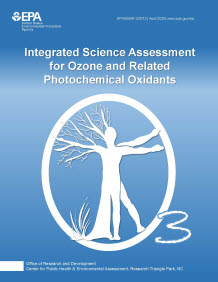Integrated Science Assessment (ISA) for Ozone and Related Photochemical Oxidants
[Notice] A new Federal Register Notice was published on April 24, 2024 announcing the Workshop To Inform Review of the Ozone National Ambient Air Quality Standards. A proceedings document that includes a high-level summary of important topics and relevant research discussed during the four-day workshop was released in September of 2024: Proceedings for the Ozone National Ambient Air Quality Standards Science and Policy Workshop.
On this page:
Overview
The Issue
Ozone is a gas that occurs both in the Earth's upper atmosphere and at ground level where it is a key component of urban smog. Ground-level ozone causes a variety of effects on human health, vegetation, and ecosystems and it affects climate. Human exposure to ozone is associated with respiratory and cardiovascular effects. Ozone exposure causes visible foliar injury, decreases plant growth and affects ecosystem community composition.
Peak ozone levels typically occur during hot, dry, stagnant summertime conditions. Millions of Americans live in areas where ozone levels exceed EPA's health-based air quality standards, primarily in parts of the Northeast, the Lake Michigan area, parts of the Southeast, southeastern Texas, and parts of California.
EPA Action
EPA scientists are evaluating the latest scientific information to better understand the relationship between exposure to ozone and health and welfare effects, who may be at increased risk to these effects, how particles form in the atmosphere, and what the contributions are from various sources in different regions of the country.
The Clean Air Act requires EPA to periodically review the science for six major air pollutants, including ozone. EPA's Center for Public Health and Environmental Assessment (formerly National Center for Environmental Assessment) develops Integrated Science Assessments (ISAs) that summarize the science related to the health and welfare effects of these pollutants. ISAs provide a comprehensive review of the policy-relevant scientific literature published since the last National Ambient Air Quality (NAAQS) review and in conjunction with other technical assessments, provide the policy-relevant scientific information necessary to conduct a review of the adequacy of the current NAAQS. This ISA represents EPA’s latest evaluation of the scientific literature on the potential health and welfare effects associated with ozone and updates the 2020 Integrated Science Assessment for Ozone and Related Photochemical Oxidants Final Report.
- Learn about the Integrated Science Assessment for Ozone and Related Photochemical Oxidants (2020)
- Learn about the Ozone Air Quality Standards
History of the Ozone and Related Photochemical Oxidants Assessments
Peer-Reviewed Literature
While working on the assessment of ozone, EPA used the Health and Environmental Research Online (HERO) database to augment the underlining literature that supported the final assessment.
See: ISA for Ozone and Related Photochemical Oxidants (2019 Final Project Page)
HERO is a searchable database of more than 1.6 million scientific studies and other references used to develop EPA assessments aimed at understanding the health and environmental effects of pollutants and chemicals.

